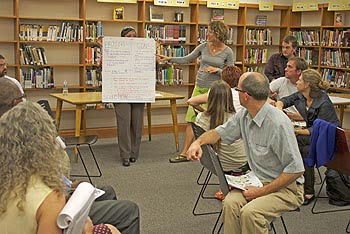Asheville Board of Education Considers Year-Round Schools

With education changing rapidly on an international scale, would year-round schooling solve our nation’s concerns about students’ academic performance? Would it help close the achievement gap? Would it help produce more globally competitive citizens?
It is questions like these that lie at the heart of debates about whether or not to make schooling a year-round institution.
Closing the educational achievement gap is the sole motivator behind a proposal to convert Asheville City Schools to a year-round curriculum. However, some studies show no conclusive evidence that adopting a year-round curriculum improves a student’s academic success.
On a local level parent, educators, and Asheville City School administrators are meeting to discuss the possibilities of year-round schooling and to try to find consensus as to what type of learning structure would best serve the students. Many parents and educators agree that “the good old days” of traditional schooling are fast becoming obsolete, yet year-round schooling proposals have generated strong feelings, both positive and negative.
Local parents who have participated in recent sessions were asked to discuss and record their list of “Pros and Cons” of year-round schooling.
Pros
• Potential for reducing summer educational loss
• All schools would be the same academically
• Children stay more engaged
• Provides continuous learning
• Reduces time during intercession to prevent failed courses
• Less teacher burn-out
Cons
• No measurable goals presented
• Children who suffer from transition issues will be affected
• Where is the money coming from for intercession programs?
• Parents might pull their children out of public schools because of the change
• Loss of summer employment for teenagers
• How to deal with extracurricular activities (sports)
Additionally, some North Carolina statistics are worth considering in the ongoing discussion.
• 53,800 students in NC dropped out of school 2010
• $4.4 Billion in lost wages and productivity
• $492 Billion cost in medical care
• $233 Million per year in savings if there is a 5% reduction in male dropouts
According to U.S. Secretary of Education Arne Duncan, the reality of what American schoolchildren are competing against in the global economy is ever-changing. And it is a reality that many parents, lawmakers, and voters in America still have not yet fully comprehended or grasped.
Duncan notes, “In practical terms, globalization means that U.S. students will have to compete throughout their careers with their peers. The race to boost educational attainment and economic competitiveness is a race that—to be brutally honest—the United States is losing. Just one generation ago, the United States had the highest proportion of college graduates in the world. Today, in eight other nations, including South Korea, young adults are more likely to have college degrees than in the U.S.”
One aspect of year-round schooling that deserves intensive scrutiny is what effects such a schedule has on students’ attitudes toward school, their academic performance, and other factors.
Attitudes
Several different studies have been conducted to learn more about the attitudes of students who attend year-round schools. The majority of these studies show that students’ attitudes towards school improved significantly as they spent more time on a year-round schedule. Students who attend year-round school say that their calendar is more balanced than their peers who have a typical school calendar
Academic Performance
Students who attend year-round schools typically do as well as or slightly better in school than their peers who attend a traditionally scheduled school.
Achievement Gap
How much of the achievement gap is the result of things that happen during the school year and how much of it is a result of things that happen during summer vacation? For at-risk, low performing students, it is clear that more frequent, short breaks provide struggling students more time for help. These breaks can be used for remedial courses, tutoring, and enrichment, if needed.
Year-round schedules deliver the same number of total days of classroom education and vacation as traditional calendars, but with vacation days distributed differently throughout the year. Academics contend that by eliminating the long summer break, the gap in learning that children experience in the present system should be eradicated.
Continuity of Instruction
During the extensive summer break, usually 10 to 12 weeks long, in traditional school system schedules, many students fail to retain what they have learned in the previous school year, and they face the additional burden of a long gap in learning during the summer. The absence of both the regular habit of attending school and the daily reinforcement of what has been learned, along with building on previous knowledge, has the strongest impact on low-income and at-risk students whose families cannot offer their children vacation travel, day trips, summer camps, and other learning enrichment opportunities – either because they cannot afford it or because their jobs do not offer the luxury of paid vacation time.
Flexible Kindergarten Entrance
Year-round school scheduling can make it possible for more flexibility in when kindergartners begin school, so that the timing can be better matched to individual development.
Overcoming Overcrowding
When a school or district is experiencing overcrowding, a multi-track year-round school schedule can provide a solution that doesn’t require investing in new buildings or temporary structures.
The intercession periods created by a single-track year-round school schedule are felt to be valuable for remediation and enrichment, rather than these opportunities coming once a year during summer school.

Family involvement
Whether schools follow a year-round schedule or the traditional nine-months-on/three-months-off schedule, it is essential that parents and other family members support their children’s education by ensuring a climate in which learning is valued. What follows is a list of things parents can do to help their children become more academically oriented:
Become academically oriented
• Read to your child daily through 8th grade / listen to child read
• Put books in your home
• Conversation / hold off on “because I said so”
• Recite a “School Pledge”
• Turn off the TV / video games
• Establish a quiet place for homework
• Let your child see you reading
Prevent Summer Loss
• Stay academically oriented
• Ask your principal/BOE to extend time kids in school (more time to learn what needs to be learned AND less time to unlearn it!)
• Read to your child daily through 8th grade / Listen to child read
• Turn off the TV / video games
• Tape recorder reading
• Find free summer enrichment activities
Esther Fusco, a professor at Hofstra University’s School of Education, Health and Human Services, says that overall, “Research suggests that students in high-needs districts and those who have disabilities do better in year-round learning situations. This is logical because these students do not have the down time that occurs over the summer. But the results are not very significant. I have not seen any study that shows students greatly improve.”
Secretary Duncan summed up his message this way. “Policymakers and voters have treated international competitiveness for too long as a zero-sum game. The success of other nations at increasing educational attainment and economic competitiveness has been assumed to be America’s loss.
“The belief that another country’s gain in economic competitiveness is America’s loss is a remnant of the Cold War mentality and a protectionist ethic. It stems from a worldview in which prosperity depends on a state’s ability to preserve a finite amount of goods and human capital.
“I want to suggest to you today that enhancing educational achievement and economic viability overseas and at home is really more of a win-win game; it is an opportunity to grow the economic pie, instead of carve it up.
“On the whole, education and economic competition can produce enormous benefits for the world and for the United States. The U.S. reaps rich benefits when educational attainment rises—both from an influx of well-educated immigrants and from rising demand for American products from better-educated populations overseas.”








